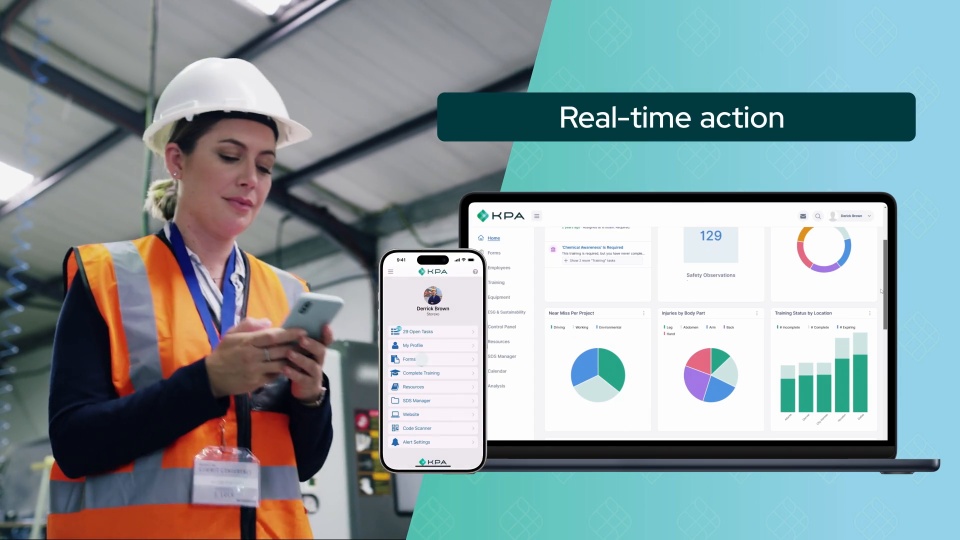Keeping workers safe is getting more complex every year. If you’re a safety manager, EHS professional, or business owner, you need to know where the biggest risks are and how to protect your team. We’ve analyzed the latest data from both OSHA and the National Safety Council to give you a complete picture of workplace safety.
Key Findings: The Top 10 Most Dangerous Jobs
The latest safety data reveals several industries facing significant safety challenges, particularly in hazardous working conditions. Based on various risk factors including fatality rates, total incidents, and days away from work, these four industries emerged as particularly high-risk.
1. Agriculture, forestry, fishing and hunting – Highest death rate per 100,000 workers
2. Construction – Most total workplace deaths
3. Transportation and warehousing – Highest recordable injury and illness rate per 10,000 workers
4. Education and health services – Most non-fatal injury and illness cases
Our Better Workforce Blog is your Ultimate Guide!
Stay informed with weekly industry updates, expert insights, best practices, and actionable tips to enhance workplace safety and compliance.
Understanding the Numbers Behind the Most Dangerous Jobs in the United States
The scale of workplace safety incidents highlights the ongoing need for improved safety measures. OSHA’s comprehensive data collection reveals concerning statistics:
- Over 1.5 million work-related injuries and illnesses
- 18.5 million days away from work
- 22.4 million days of job transfer/restriction
- 851 workplace fatalities
Industry-Specific Risk Analysis
Each high-risk industry faces unique challenges and safety concerns. Here’s a detailed breakdown of the key risk factors and statistics for each sector:
Fatal injury rate: 98.9 per 100,000 workers
Total deaths (2023): 52
Salary: $48,060
Most common fatal accidents: Contact with objects and equipment, which are among the deadliest hazards in the construction industry.
The most dangerous job in America is logging. Logging workers had a fatal accident rate that was 2,700% larger than the average job nationwide.
Logging workers harvest forests to provide the raw material for goods such as wood, paper, and cardboard, in addition to other industrial products. These workers spend almost all of their time outside in forests and other isolated areas, which can present hazardous working conditions.
Logging workers use heavy machinery to fell trees and handle logs. Logging worker deaths are most often caused by contact with logging machines or logs.
Fatal injury rate: 86.9 per 100,000 workers
Total deaths (2023): 19
Salary: $48,060
Most common fatal accidents: drowning, weapon discharge
Fishing and hunting operations are conducted under various environmental conditions, depending on the geographic region, body of water or land, and kinds of animals sought. Storms, fog, and wind may hamper fishing vessels or cause them to suspend fishing operations and return to port.
Most fatalities that happen to fishers and related fishing workers are from drowning. The crew must guard against the danger of injury from malfunctioning fishing gear, entanglement in fishing nets and gear, slippery decks, ice formation, or large waves washing over the deck. Malfunctioning navigation and communication equipment and other factors may lead to collisions, shipwrecks, or other dangerous situations, such as vessels becoming caught in storms.
Hunting accidents can occur because of the weapons and traps these workers use. Hunters and trappers minimize injury by wearing the appropriate gear and following detailed safety procedures. Specific safety guidelines vary by state.
Fatal injury rate: 51.8 per 100,000 workers
Total deaths (2023): 113
Salary: $48,060
Most common fatal accidents: Falls, slips, trips
Roofers are responsible for installing, repairing, and replacing roofs on homes and buildings. Their work involves taking roofing materials such as shingles, metal, or other materials onto roofs and securing them. Roofers generally must use ladders or other equipment to climb on top of buildings. The most common cause of fatal work injury for roofers is falling off roofs or ladders.
Fatal injury rate: 41.4 per 100,000 workers
Total deaths (2023): 41
Salary: $39,100
Collect and dump refuse or recyclable materials from containers into truck. May drive truck.
Fatal injury rate: 31.3 per 100,000 workers
Total deaths (2023): 62
Salary: $171,210
Most common fatal accidents: Transportation incidents
Aircraft pilots fly and navigate airplanes, helicopters, and other types of aircraft. In this profession, pilots are responsible for checking the condition of aircraft before and after flights, ensuring the aircraft is balanced, and planning for fuel and flight plans. Pilots also operate the aircraft, communicate with air traffic control, and monitor the aircraft’s systems during flight.
The majority of aircraft pilot fatalities occur in crashes of privately owned planes and helicopters rather than on regularly scheduled commercial jet aircraft.
Fatal injury rate: 27.4 per 100,000 workers
Total deaths (2023): 16
Salary: $48,060
Most common fatal accidents: falls, contact with objects, and other on-the-job incidents that pose significant risks.
Construction laborers and helpers perform tasks, such as using, supplying, or holding materials or tools and cleaning work areas and equipment, on construction sites.
Construction laborers have one of the highest rates of injuries and illnesses of all occupations. Injuries may result from incidents such as slips, falls, and contact with objects or equipment. Workers reduce the risk of injury by following safety procedures and practices, such as wearing a hardhat, steel-toed shoes, or other personal protective equipment (PPE).
Fatal injury rate: 26.8 per 100,000 workers
Total deaths (2023): 984
Salary: $48,060
Most common fatal accidents: Transportation incidents
Delivery drivers load and unload trucks or cars and drive them to their destination within a local area. These workers generally pick up cargo, food, laundry or other items from distribution centers or stores and deliver them to homes and businesses. They also may communicate with customers to coordinate deliveries, collect payment for goods, and process paperwork such as delivery signatures.
Traffic crashes are the leading cause of death on the job for driver/sales workers and truck drivers.
Fatal injury rate: 20.5 per 100,000 workers
Total deaths (2023): 226
Salary: $23.11/hr
Most common fatal accidents: Falls, slips, trips
Landscaping supervisors are responsible for coordinating and supervising the work of landscapers, lawn maintenance workers, and groundskeepers. In this role, landscaping supervisors manage landscaping projects, enforce workplace standards, inspect work, and instruct workers in the proper techniques for performing landscaping work. The most common cause of death for landscaping workers is falls, which can occur when working from heights performing tasks such as tree trimming.
Fatal injury rate: 20.2 per 100,000 workers
Total deaths (2023): 146
Salary: $48,060
Most common fatal accidents: Transportation incidents
Agricultural workers are responsible for tending crops and livestock. They may be tasked with planting, harvesting, and watering crops, along with maintaining irrigation systems and ditches. These workers can also use farm tools or equipment, as well as apply pesticides and fertilizers. For agricultural workers who work with livestock, they may be responsible for feeding animals and keeping animal living areas clean. Transportation incidents are the most common fatal accidents for agricultural workers, which can occur while these workers are moving between or to and from worksites.
Fatal injury rate: 19.8 per 100,000 workers
Total deaths (2023): 9
Salary: $48,060
Most common fatal accidents: Falls from heights
Structural iron and steel workers erect, place, and join steel girders, columns, and other pieces to form structural frameworks. They also may assemble precut metal buildings and the cranes and derricks that move materials and equipment around the construction site, which can be hazardous without proper safety measures. Some ironworkers install precast walls or work with wood or composite materials.
The work of ironworkers can be dangerous. Common injuries include cuts, sprains, overexertion, and falls; from great heights, falls can be deadly. To reduce these risks, ironworkers must wear safety equipment such as harnesses, hard hats, boots, gloves, and safety glasses.
Risk Prevention Strategies for High-Risk Industries
Safety managers can implement these proven strategies to start improving workplace safety right away:
1. Implement comprehensive safety training programs
2. Conduct regular safety audits
3. Use data-driven risk assessment tools
4. Maintain detailed incident tracking
5. Deploy mobile safety observation tools
Long-term Prevention
Creating lasting change requires a sustained commitment to safety. Consider these long-term strategies for your safety program:
– Develop industry-specific safety protocols
– Create emergency response plans
– Establish regular safety committee meetings
– Implement continuous improvement programs
– Utilize safety management software
How Technology Can Help
Modern safety management has evolved beyond paper checklists and manual tracking. Today’s EHS software solutions offer powerful tools that transform how organizations manage workplace safety, particularly in relation to occupational safety and health.
– Real-time incident tracking and reporting
– Mobile safety inspections
– Automated compliance monitoring
– Training management systems
– Risk assessment tools
– Corrective action tracking
Bottom Line: Making Workplace Safety a Priority
The data shows that workplace safety remains a critical challenge across industries. However, with proper safety protocols, regular training, and the right technology tools, organizations can significantly reduce their risk of workplace incidents.
Want to learn how to better protect your workers and reduce safety risks? Contact us to learn how KPA’s EHS software and consulting services can help you build a stronger safety program.
Related Content
Explore more comprehensive articles, specialized guides, and insightful interviews selected, offering fresh insights, data-driven analysis, and expert perspectives.


